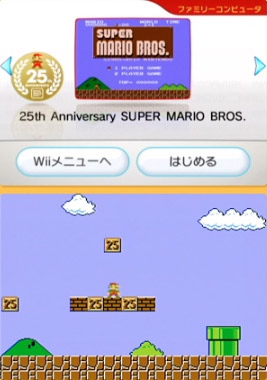So, Nintendo’s Giving Away Prototype ROMs
Wednesday, November 17th, 2010To celebrate the 25th anniversary of the release of Super Mario Bros, Nintendo is releasing a lineup of special edition Wii consoles, with each of the world’s regions receiving a different pack-in bonus.
Japan gets a red Wii with a free preinstalled copy of 25th Anniversary Super Mario Bros, a modified edition of the game that changes the question mark blocks to display the number “25.”
Europe receives the same red Wii packaged with New Super Mario Bros, Wii Sports, and Donkey Kong: Original Edition, a massively important release that I’ll get back to in a moment.
The United States, meanwhile, gets a red Wii packaged with New Super Mario Bros, Wii Sports, and an exclusive batch of jack squat.
Let’s return to Donkey Kong: Original Edition. Among other enhancements, this version of the game restores the cement factory level, which previously remained exclusive to the arcade version of Donkey Kong and a handful of ports for consoles and personal computers.

Notably, the cement factory level was omitted from Nintendo’s official home console port of Donkey Kong, which debuted for the Famicom in 1983. The same game — again minus the factory level — was later released for the Nintendo Entertainment System as both a standalone cartridge and bundled with Donkey Kong Jr. in Donkey Kong Classics.
So what’s the big deal here? Well, if you watch the preview video above, you might notice that Donkey Kong: Original Edition is not an emulated copy of the arcade version of Donkey Kong, nor is it a newly reprogrammed port.
It’s emulated — note the slightly slower gameplay and music due to PAL video conversion — but it’s also obviously based on the existing NES port, complete with that particular version’s subtly unique graphics and gameplay mechanics.
My hypothesis, then, is that Donkey Kong: Original Edition isn’t an original creation hacked together for a special edition Wii bundle — it’s actually the holiest of gaming grails: an unreleased prototype of a first-party Nintendo game.

In contrast with Donkey Kong: Original Edition, the differences in 25th Anniversary Super Mario Bros. are trivial. Changing a copyright date and a single graphic is something that anybody can do with freely available ROM hacking utilities.
Expanding a ROM image in order to add an entirely new level with its own unique gameplay mechanics is a different story. The process would be extremely difficult for even the most talented ROM hacker, and it’s unlikely that anyone at Nintendo nowadays has the specific skillset needed to create original programming to add new content to a 27-year-old game.
I can’t imagine that Donkey Kong: Original Edition is anything other than an enhanced version of the game that Nintendo developed itself and planned to release during the NES’s lifespan — perhaps even as a UK exclusive.

It wouldn’t have been an unprecedented move on Nintendo’s part. In 1993, Nintendo released an enhanced version of Mario Bros. for the NES exclusively in Europe, restoring many elements from the arcade version that were omitted in a previous port. This specific version never saw release outside of Europe, and has yet to resurface as a Virtual Console download in any region.
It’s not often that Nintendo reaches into its back catalog to re-release past obscurities — Super Mario Bros: The Lost Levels and The Legend of Zelda: Ocarina of Time – Master Quest are rare examples — but this could be the first time that Nintendo has officially acknowledged and then released a game that was previously canceled.

What’s the next step for Nintendo from here? Wii bundles that include Earthbound Zero and the scrapped NES port of SimCity? Virtual Console debuts for the unreleased Donkey Kong’s Fun With Music and Return of Donkey Kong? Will we finally discover the secrets behind the mysterious Yeah Yeah Beebiss I???
I can guarantee that none of these things will ever happen. Sorry. But hey, at least we get to play that cement factory level now.
[via Tiny Cartridge, The Gay Gamer]








